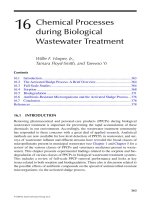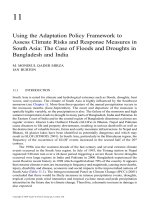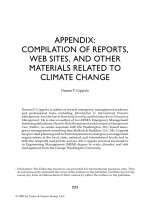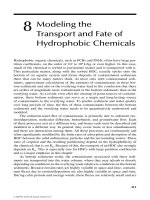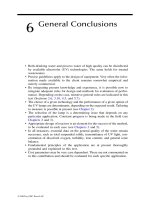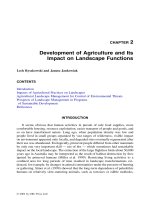LANDSCAPE ECOLOGY in AGROECOSYSTEMS MANAGEMENT - CHAPTER 16 (end) ppsx
Bạn đang xem bản rút gọn của tài liệu. Xem và tải ngay bản đầy đủ của tài liệu tại đây (126.8 KB, 8 trang )
CHAPTER
16
Agriculture and Landscape Ecology
Lech Ryszkowski
CONTENTS
Overview
The New Common Agricultural Policy (CAP)
Sustainable Agriculture
Landscape Management in Development of Sustainable Agriculture
Conclusion
References
OVERVIEW
It can be argued that objectives for agriculture are inherently different from those
for nature protection, and, therefore, it is unwise to rely on the agricultural manage-
ment of land as the primary means for environmental protection. As agricultural
productivity expanded, natural landscapes were converted to rural landscapes com-
posed of cultivated fields, pastures, settlements and patches of nonarable habitats.
Farmers, to a great extent, have been responsible for the development and steward-
ship of the landscape. Agricultural activity is focused on production; therefore, all
available resources were used to maximize yields. This attitude led to neglecting the
importance of all nonproductive elements of the rural landscape and, because of a
lack of knowledge, resulted in the widespread treatment of small patches of wetlands,
mid-field ponds, hedges, groves, and so on as idlelands, or habitats of no use.
There seems to be little question that, because of this attitude, as cultivated fields
were developed, to increase production, many nonproductive landscape elements
were eradicated, leading to landscape uniformity. When the intensification of agri-
cultural production increased to the point that the landscape’s capacities to buffer
0919 ch16 frame Page 341 Tuesday, November 20, 2001 6:34 PM
© 2002 by CRC Press LLC
the side effects from farming were overcome — which was facilitated by loss of
landscape diversity — environmental threats started to appear. Accelerated rates of
water and wind erosion, diffuse pollution of water reservoirs, lowered ground water
levels, increased frequency of floods, broader variation in microclimatic factors,
outbreaks of crop pests, and many other phenomena brought by farming intensifi-
cation began to be observed worldwide.
Two reports on changes in the European environment (Stanners and Bourdeau
1995, European Environment Agency 1998), requested by the environment ministers
for all of Europe, clearly documented environmental deterioration from agriculture,
industry, urbanization and other human activities. The same situation in other parts
of the world is evidenced by a variety of publications. Although there has been much
more concern shown for environmental threats caused by industry or urbanization,
agricultural activities have played an important role in overall human impact on the
environment. Ground water quality can be decreased by high concentrations of
nitrates brought by the use of artificial fertilizers and manure on cultivated fields.
The spatial scale of these impacts can be enormous. Stanners and Bourdeau (1995),
using the figures provided by model computations, reported that the nitrate concen-
trations levels in ground water from 87% of the agricultural land in Europe exceeded
25 mg·l
–1
(the European Union target value) due to leaching from soils. The drinking
water standard of 50 mg·NO
3
–
·l
–1
was exceeded in 22% of the area. Light soils, high
inputs of nitrogen fertilizers, and the loss of small nonarable habitats, such as
permanent vegetation patches and mid-field wetlands and ponds, are the main factors
leading to high nitrate passing loads into aquifers. Contamination of water by
pesticides leached from soils, erosion, soil compaction, desertification, impoverish-
ment of biological diversity, pest outbreaks, and other threats to agroecosystems
have been recognized not only by scientists but more recently even by decision
makers.
THE NEW COMMON AGRICULTURAL POLICY (CAP)
These environmental considerations became an important issue during the for-
mulation of the new Common Agricultural Policy (CAP) in the 1990s by the Euro-
pean Union (EU) within the context of Agenda 2000, issued in 1997, which included
a revised EU policy on development. The CAP, which makes up one of the sectorial
policies of Agenda 2000, proposes that farmers should observe a minimum standard
level of environmental protection measures defined in the codes of good agricultural
practices and that any additional environmental services should be financed by
society through agro-environment programs.
Enacting such administrative regulation is a good example of the formulation of
new feedback loops that help build control mechanisms, thereby facilitating devel-
opment of sustainable agriculture. One of the prerequisites for maintenance of a
sustainable agricultural system is the existence of negative feedback loops in which
outputs (e.g., environment threats) influence the inputs (e.g., use of particular pro-
duction means); otherwise, the system loses its integrity and may transform to
another state. A network of negative feedback determines the resilience of the system
0919 ch16 frame Page 342 Tuesday, November 20, 2001 6:34 PM
© 2002 by CRC Press LLC
to environmental disturbances. Distortion of landscape functions that may be caused
by farming intensification and lead to altered energy fluxes and organic matter
cycling patterns should either (1) be counteracted by mechanisms (negative feed-
backs) that diminish inputs that cause threats or (2) be controlled by rearranging the
system structure in such a way that the distortion itself is arrested. It is important
to note that because the landscape distortions are caused by farmers, the elaboration
of negative feedback mechanisms should encompass both environmental and societal
components of the landscape.
The development of the new CAP has relied mainly on the first method to
counteract increased environmental deteriorations. The CAP reform marks an impor-
tant step toward implementing a sustainable agriculture, thereby enabling the tran-
sition from identification of a crisis to its control. In other words, it is a transition
from recognizing the causes of environmental threats and observing their impact on
the economy or living conditions of the general public, which stimulates calls for
the administration to take action, to undertake effective measures to control the
actual threats. This transition was realized by involvement of administrative struc-
tures of society in the control of threats. The sooner we understand that scientific
recognition of environmental impacts, public pressure on administration to eliminate
such threats, and the forging of control regulations by decision makers are a normal
part of learning to deal with crises, the easier it will be to design policies of
sustainable development. The efficiency of such control mechanisms depends very
much on the elaboration of the ways of opening channels of communication between
those who understand the process in question and the general public and decision
makers.
The environmental problems created by agriculture are handled within the con-
text of the new CAP mainly by imposing restrictions on agricultural activities —
for example, the Nitrates Directive issued by the Commission of the European
Communities (CEC) in 1991 — or by protection of biota as well as habitats against
human interferences — for example, the Birds Directive issued in 1979 or the
Habitats Directive of 1992. Thus, the concerns are directed toward mechanisms
constraining intensity of inputs that are causing the threat (elaboration of negative
feedback loops concept).
Implementation of the Nitrates Directive has been rather unsuccessful (Com
1999). One reason is probably that the Nitrates Directive does not mandate com-
pensation to farmers because of the “polluter pays” principle, which requires farmers
to observe good agricultural practices without payment. This situation demonstrates
that the efficiency of negative feedback loops that encompass societal structures is
to some extent tied to the exchange of capital.
The main restrictions of the Nitrates Directive are connected with further elab-
oration of limits on amounts of fertilizers used and imposed requests concerning
delimitation of areas sensitive to leaching. In addition, special thresholds for appli-
cation of inorganic and organic fertilizers and modified tillage technologies that are
proposed should be observed. Both the Birds and Habitats Directives provide a basis
for setting up the EU program on nature conservancy (Natura 2000) consisting of
the establishment of a refuge sites network, where bird protection measures are
implemented and certain agricultural activities that threaten the biota are restricted.
0919 ch16 frame Page 343 Tuesday, November 20, 2001 6:34 PM
© 2002 by CRC Press LLC
SUSTAINABLE AGRICULTURE
The most important achievement of the new CAP is its recognition of landscape
properties for the sustainable development of agriculture (Com 1999). The study of
landscape properties leads to disclosure of links between natural and societal pro-
cesses that change landscape structures and also provide opportunities for economic
activities. A landscape has multifunctional characteristics that make it significant as
a material object but also creates a sensitive relationship between humans and their
environment. The sustainability concept is based on three main pillars — economic,
social, and environmental — which should be balanced in such a way that change
in one pillar does not undermine the whole system. Thus, production increases should
complement a higher standard of life and also sustained improvement in the quality
of the environment. Maintenance of such a situation could be achieved by two
systems of management. The first system relies on development of more environ-
mentally friendly technologies that can be used when production is increasing. The
second system focuses on building buffer capacities in the system that could neu-
tralize any negative side effects of the increased production.
The codes of good agricultural practices describe ways to introduce environmen-
tally friendly technologies, but enforcement requires administrative regulations.
Maintenance of good soil quality and soil fertility can provide long-term economic
gains. Cultivation technologies that aim to increase storage capacity of soil and to
preserve or improve its physical, chemical, and biological properties are of the utmost
importance for successful development of sustainable agriculture.
In the arsenal of available technologies one can include diversified crop rotation
patterns, minimizing exposure of bare soil, which constrains erosion rates and
simultaneously prevents accumulation of hazardous biochemical compounds (e.g.,
phenolic acids) that inhibit growth of cultivated plants (Ryszkowski et al. 1998).
Plowing green manure into soil as well as frequent application of farm manure
restores and preserves the organic matter in soils that have the most importance for
sustaining soil fertility over long periods. Increased integration of crop and animal
production within the farm, leading to tight recycling of nutrients and therefore less
loss of nutrients to ground and surface water reservoirs (Granstedt 2000), is another
option for farm-level control of environmental problems. Integrated methods of pest
and disease control can reduce the use of pesticides and no-till technologies and can
restore the physical and chemical properties of soils as well as stimulate rich com-
munities of soil microorganisms.
Nevertheless, as shown by Ryszkowski and Jankowiak in Chapter 2, all those
technologies cannot eliminate problems caused by agriculture; they can only reduce
them. Agroecosystems can be managed for simplification of their structure which
facilitates higher yields but also decreases efficiency of their recycling processes
and stimulates diffuse pollution in an entire region. Water and microclimate man-
agement issues must also involve very large areas to be effective. The same can be
said with regard to protecting biodiversity.
The effective introduction or rearrangement of linear or clump elements, such
as groves, shelterbelts, stretches of grasslands, mid-field ponds and wetlands, riparian
vegetation strips, and stone wells, all of which function as biogeochemical barriers,
0919 ch16 frame Page 344 Tuesday, November 20, 2001 6:34 PM
© 2002 by CRC Press LLC
can influence the rates and direction of basic processes in the landscape, but can be
accomplished only on a scale much larger than a single farm.
This analysis leads to an important conclusion. The farm is an autonymous or
self-sufficient unit with respect to its economic processes. But a farmer’s sovereignty
over the natural processes is not great. Thus, there is a considerable functional
discrepancy between a farm as an economic enterprise and its role in environmental
protection programs. The activities within the farm may be on too small a scale to
curb environmental deterioration. This does not mean, however, that environmentally
friendly technologies are not important. On the contrary, they are very important,
but their execution needs to be coordinated on a large spatial scale, including many
farms, to achieve significant impact on a range of the natural processes in question.
This situation calls for coordination of farmers’ activities at the landscape level. In
addition, the introduction of biogeochemical barriers may interfere with economic
benefits obtained by individual farmers; therefore, the decision on their optimal
localization should be undertaken from the perspective of protecting the interests of
all of society (the societal pillar of sustainability) rather than those of the individual
farmers. The problems and conflicts arising in such situations were analyzed well
by Hardin (1968).
LANDSCAPE MANAGEMENT IN DEVELOPMENT
OF SUSTAINABLE AGRICULTURE
The problems of spatial layout and design of various landscape elements can be
addressed by spatial planning, which recently became one of the new dimensions
of the EU policies of development. In order to reconcile the social and economic
claims for spatial development with an area’s ecological and cultural functions, the
program for the European Spatial Development Perspective (ESDP 1999) was pro-
posed by ministers responsible for spatial planning in the EU member states. With
respect to agriculture, this political initiative aims not only at delimiting regions
having different production intensity or specific problems (such as excessive spe-
cialization or concentration of production) but also indicates the need for recognizing
the interactions between agriculture and other sectorial activities in order to find
synergies that may result. The proposed ESDP policy based on those findings should
lead to strategies for minimizing conflicts between different land users, for example
between farmers and nature conservationists, by implementing the Natura 2000
program on a wide network of protected areas. According to the ESDP, “a broader
land-use policy can provide the context within which protected areas can thrive
without being isolated.”
Recognition of the importance of spatial dimensions in the relationships between
economic and societal aspects introduces broader possibilities to manage the negative
effects of development. These negative effects can be combated with suitable
regional planning that minimizes conflicts (ESDP 1999). Thus, the policy incentives
mentioned above provide new options to moderate conflicts between sectorial activ-
ities and the social well-being of the people.
0919 ch16 frame Page 345 Tuesday, November 20, 2001 6:34 PM
© 2002 by CRC Press LLC
One can expect that the development of the ESDP policy will also influence the
CAP expanding arsenal of measures for controlling environmental deterioration from
agricultural intensification. The discussion of the control measures of environment
deterioration proposed by the CAP, presented at the beginning of this chapter, showed
that regulations rely mainly on restricting the sources of environmental threats (e.g.,
Nitrate Directive). Methods for building resistance to threats at the landscape level
are still not a broadly used operational option, although Recommendation Nr. R(94)6,
on sustainable development and use of the countryside with a particular focus on
safeguarding wildlife and landscape (issued by the Council of Europe in 1994)
proposes structuring landscape with hedges, ponds, and buffer zones. The aim of
those activities is the stimulation of natural processes of landscape self-purification
and control of diffuse pollution. Nevertheless, to date, there is no EU directive for
enhancing landscape resistance to environmental threats. Such regulations will rein-
force the arsenal of current regulations with a new category of measures that allow
some intensification of production with side effects that could be neutralized by
natural processes enhanced through landscape management.
This new approach to control of environmental threats has a very important
implication for the development of sustainable agriculture. More intensive agricul-
tural production results in higher yields, which in turn provide opportunities for
improved economic revenue. This aspect is of special interest to farmers for whom
a positive link between income and environmental threat control measures would
be more persuasive than would proposals restricting production.
This statement is supported by the results of a census carried out by the Research
Center for Agricultural and Forest Environment in Pozna , Poland. Farmers were
asked to identify what they considered the most important environmental threats.
The majority indicated those threats that directly impact yields, while those threats
with an indirect effect on production were either neglected or recognized only by
those farmers with a higher education. For example, 71% of 168 respondents clearly
recognized effects of drought, which decreased yields, while only 7% indicated
existing water pollution problems as important. It seems, therefore, that control
measures for environmental deterioration that do not restrict production and revenue
constitute a better strategic approach than those that establish such restrictions.
The crucial point for applying a landscape approach to controlling environmental
degradations is that side effects of agricultural production intensification should not
exceed the buffering capacities of the landscape. Observation of that condition
requires proper education of farmers and development of extension services qualified
in landscape ecology.
Landscape ecologists showed some time ago that the mosaic structure of land-
scape can stop disturbances (e.g., Forman and Gordon 1986). The review of recent
ecological studies presented in this book clearly shows that many natural processes
could be modified by a mosaic landscape structure. One of the most important results
of those studies is the indication that stands of permanent vegetation can modify
heat balances and water cycles in the countryside. Trees, for example, are efficient
ecological water pumps increasing evapotranspiration rates and at the same time
slowing surface runoff. The complicated structure of a tree stand can modify micro-
climatic conditions of adjoining fields largely because of its effects on wind velocity.
´
n
0919 ch16 frame Page 346 Wednesday, November 21, 2001 12:57 PM
© 2002 by CRC Press LLC
Cultivated fields can be considered “landscape ovens,” heating air, which could even
influence mesoscale air circulation due to increased rates of heat convection. Shel-
terbelts in a simplified agricultural landscape are one of the best tools by which one
can manage not only microclimatic conditions but also water cycling in the land-
scape. The tradeoff between those processes depends on the kind of biogeochemical
barrier, its structure, and the pattern of the network.
A network of biogeochemical barriers can also efficiently control diffuse water
pollution if combined with management practices aimed at the removal of accumu-
lated plant debris, which rapid decomposition under favorable microclimatic condi-
tions can turn a biogeochemical barrier from a sink to a source of contaminants.
The biological processes of nutrient uptake, denitrification, assimilatory reduction
of nitrates, and decomposition of organic matter play very important roles in the
process of nitrogen cycling in the landscape. It seems that processes of biological
recycling within the biogeochemical barrier play a substantial role in processes that
determine the control of the barrier for modification of adverse matter cycles in
landscapes.
A mosaic of refuge sites in the agricultural landscape houses much richer and
more diverse plant and animal communities than does a uniform landscape that is
composed of large cultivated fields and that largely lacks other nonagricultural
landscape components. Analyses indicate that a more diversified landscape structure
stimulates the appearance of a larger number of taxa as well as greater density and
biomass of the animal communities. In nonarable habitats sheltered by the bio-
geochemical barriers, for example, mid-field ponds separated from fields by mead-
ows or hedges, even protected or rare species can thrive in the agricultural landscape.
The success of biodiversity protection by the biogeochemical barriers depends on
farming operations. Thus, a tradeoff between farming intensity and pattern of refuge
sites must be established in order to reconcile agricultural activities with biodiversity
protection.
Elaboration of the methods of decision making in regard to proposed land uses
constitutes the important step reported in this book to communicate landscape
ecology achievements to policy makers. Development of computer tools to model
the environmental consequences of proposed land-use changes can facilitate the
incorporation of landscape ecology guidelines into agricultural policies. The same
is true for elaboration of operational guidelines for managing biogeochemical bar-
riers, e.g., instructions on management practices for shelterbelt maintenance. Such
modeling can also help efficiently translate landscape ecology into common practice,
such as attempts to introduce riparian forest buffers into the U.S. program for water
quality protection.
CONCLUSION
Trends in the development of agricultural policies, as shown in the example of
the EU common agricultural policy, as well as the achievements of landscape ecology,
described above, indicate that in the future one can expect a merging of those fields
of human activities to provide more efficient ways to develop sustainable agriculture.
0919 ch16 frame Page 347 Tuesday, November 20, 2001 6:34 PM
© 2002 by CRC Press LLC
It seems likely that agrolandscape ecology will be an important discipline that will
influence agricultural practices in the 21st century. These tasks are not easy to
accomplish. First, for example, restricting contamination of water reservoirs and
building environmental resistance require considerable money. Hence, poor farmers
will have difficulty implementing effective environment protection programs. Second,
farmers are still not sufficiently educated to make profitable use of the achievements
of contemporary ecology to restrict nonpoint pollution, save water, or control erosion
processes through diversifying landscapes. Environmentally friendly cultivation tech-
nologies recently proposed by various proponents of alternative agriculture indicate
a number of activities that are very sound from an ecological point of view. But the
efficiency of environmental protection of rural areas could be enhanced even further
if field practices could be supplemented by structuring landscapes with various bio-
geochemical barriers, which would not only augment control of nonpoint pollution,
save water, and modify microclimatic conditions but also conserve biodiversity.
REFERENCES
Com 1999. Direction toward sustainable agriculture. Commission of the European Commu-
nities. Brussels. 30 pp.
ESDP. 1999.
European Spatial Development Perspective
. Office for Official Publications of
the European Communities. Luxemburg. 82 pp.
European Environment Agency. 1998.
Europe’s Environment: The Second Assessment
.
Elsevier Science Ltd. Oxford. 293 pp.
Forman R. T. T., Godron M. 1986.
Landscape Ecology
. Wiley & Sons. New York. 619 pp.
Granstedt A. 2000. Increasing the efficiency of plant nutrients recycling within the agricultural
system as a way of reducing the load to the environment — experience from Sweden
and Finland.
Agric. Ecosys. Environ.
80: 169–185.
Hardin G. 1968. The tragedy of the commons.
Science
162: 1243–1248.
Ryszkowski L., Szajdak L., Karg J. 1998. Effects of continuous cropping of rye on soil biota
and biochemistry.
Crit. Rev. Plant Sci.
17: 225–244.
Stanners D., Bourdeau P. 1995.
Europe’s Environment
. European Environment Agency.
Copenhagen. 676 pp.
0919 ch16 frame Page 348 Tuesday, November 20, 2001 6:34 PM
© 2002 by CRC Press LLC
